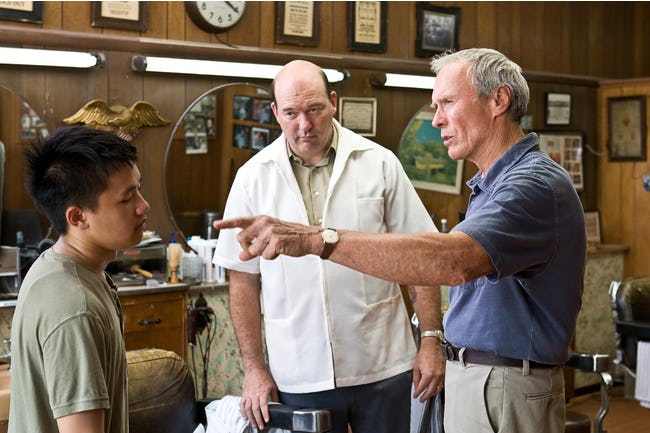Walt Kowalski - character development in 'Gran Torino' dir. Clint Eastwood
The following item gives an account of the development of the character of Walt Kowalski in 'Gran Torino'. Reading it may be useful in understanding the sorts of things you could explain in a critical essay.
Also, the development of the character of Walt is important in the film, because it goes hand in hand with the development of his relationship with Thao and the development of the theme of respect.
Clearly, since this is taken from the internet, it cannot be copied. This would be plagiarism..
Also, the development of the character of Walt is important in the film, because it goes hand in hand with the development of his relationship with Thao and the development of the theme of respect.
Clearly, since this is taken from the internet, it cannot be copied. This would be plagiarism..
A
film in which there is a character who becomes a hero is ‘Gran Torino’,
directed by and starring Clint Eastwood. The story is set in modern day
Detroit, where the central character, Walt Kowalski, a retired car plant worker
and Korean War veteran, struggles to come to terms with the changes in his
community. In particular, the plot revolves around his unlikely friendship with
Thao, a teenage boy from a Hmong immigrant family.
The
first time we see Walt is a close up of his angry face at this wife’s funeral.
This gives the impression right from the start that he is a grumpy old man with
not much time for people. In the next sequence of the film, we also find out
that Walt has an unjustified dislike for Thao. We see this when Walt uses
racist language and slams the door in his face at their first encounter. The
relationship between Walt and Thao looks to be beyond repair when Thao attempts
to steal the Gran Torino. Thao is caught and a shot/reverse shot is used to
show the tension, anger and fear between the two characters. Soon after, because
Thao’s family want him to make amends, Walt is forced to take Thao on as a
worker. Thao begins to earn Walt’s respect through his hard work and
determination. We see the first spark of a relationship between Thao and Walt.
We
realise that the relationship between Walt and Thao has changed when Walt goes
to Thao’s door asking for his help. This is a mirror image from earlier in the
movie when Thao went to Walt’s door asking for help and Walt shuts the door in
Thao’s face. This shows that Walt no longer sees him as the foreign boy next
door who tried to steal his car, but as a friend and acquaintance, and he does
not mind asking for his help when moving the freezer.
As
the plot progresses, Walt realises that Thao’s chances of success are being held
back because he is under pressure to join a troublesome gang of Hmong youths.
Walt had realised who his true friends were after the gang attacked and raped
Sue, Thao’s sister. After this, he wanted to help his Hmong neighbours, because
he cared for them. After seeing Sue in that state, he lost his temper and
smashed the glass cabinets and cupboards.
The
climax of the movie is a scene which shows Walt’s turning point from a racist
to a true friend and hero of the Hmong people. In this scene Walt makes the
most extreme sacrifice – his life. The audience sees Walt pretending to pull a
gun and he is violently shot down by the Hmong gang. This leads to them being
taken to prison, which, in turn, means that Thao and Sue can have a peaceful
future. Eastwood has chosen this scene, because it shows the change in Walt’s
racist beliefs. He ends the film a true hero.
In
this film, Clint Eastwood explored the idea of racism in USA and decided to
send a powerful message to viewers that better understanding and friendship
could overcome problems of difference. He used a wide range of film techniques
to make a very interesting and engaging film, where the central character saw
the error of his ways and became a true hero.

